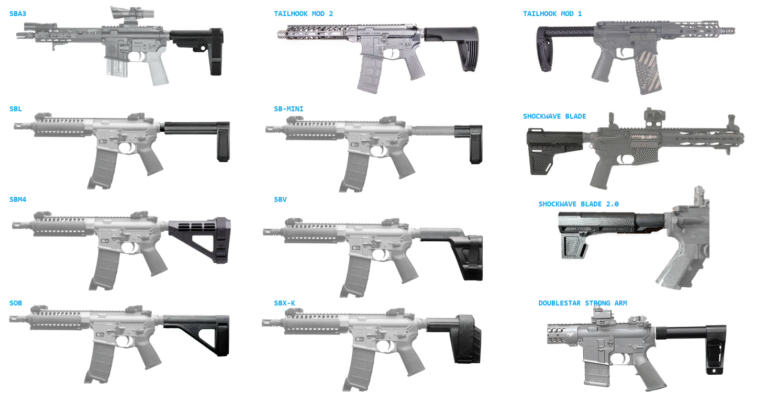Introduction
The AR pistol brace has become one of the most debated firearm accessories in the United States. What started as a device to help disabled veterans stabilize their firearms has grown into a mainstream accessory for AR pistol owners. However, its popularity has been matched with intense legal scrutiny, making it one of the most legally complex firearm topics in modern history.
This article is based on official ATF rulings ATF Firearms Rules, federal court decisions (notably the Fifth and Eighth Circuit rulings, 2023–2024), and trusted firearm industry sources, ensuring you get accurate and verifiable information.
What is an AR Pistol Brace?
An AR pistol brace, also known as a stabilizing brace, attaches to the rear of an AR-style pistol. Unlike a rifle stock, which is designed for shouldering, a brace is meant to strap onto the forearm.
The brace was first developed in 2012 by SB Tactical with input from a disabled veteran, to help shooters with limited mobility fire AR-style pistols safely SB Tactical History. This reinforces the fact that braces were created for safety and accessibility, not to bypass firearm laws.
How AR Pistol Braces Work
The core function of a pistol brace is stability without crossing into the regulatory territory of a short-barreled rifle (SBR).
Forearm Stabilization: The shooter secures the brace to the forearm, creating a stable third point of contact.
Recoil Control: By distributing recoil energy, muzzle rise is reduced.
Accuracy Gains: This stability improves precision, especially during rapid fire or unconventional positions.
Firearms trainers and industry experts note that braces can improve safety and control, especially for shooters with physical limitations.
Legal Status: ATF Rulings and Court Challenges
The legality of pistol braces has been one of the most contested issues between the firearms community and regulators.
National Firearms Act (NFA) Framework
Under the National Firearms Act of 1934 (NFA), a Short-Barreled Rifle (SBR) is defined as any rifle with a barrel shorter than 16 inches ATF NFA Guide. These firearms require a $200 tax stamp, ATF registration, and restrictions on interstate transport.
The 2023 ATF “Final Rule”
In January 2023, the ATF issued a Final Rule (Factoring Criteria for Firearms with Attached ‘Stabilizing Braces’) that sought to classify many braced pistols as SBRs Federal Register, ATF 2023R-08F.
This forced millions of owners to either:
Register their firearm as an SBR,
Remove the brace, or
Risk felony charges.
Federal Court Challenges (2023–2024)
Several lawsuits challenged the rule, including Mock v. Garland in the Fifth Circuit and Firearms Policy Coalition v. Garland in the Eighth Circuit. Both courts ruled that the ATF had exceeded its authority by effectively rewriting firearm law without congressional approval Fifth Circuit Court Opinion, 2023.
By late 2024, the ATF’s Final Rule was vacated nationwide, restoring braces to legal status.

AR Pistol Brace vs. Short-Barreled Rifle (SBR)
| Feature | Braced Pistol | Short-Barreled Rifle (SBR) |
|---|---|---|
| Legal Classification | Pistol (as of 2025) | Rifle (NFA regulated) |
| Registration | No tax stamp required | $200 NFA tax stamp required |
| Foregrip Rules | Angled foregrip allowed, vertical foregrip not | Both angled & vertical allowed |
| Portability | Highly portable, easier for CQB | Requires approval to move across state lines |
| Primary Use | Home defense, compact carry setups | Tactical training, precision shooting |
This table reflects current federal firearm law, but state laws may differ. Always check your local regulations.
Choosing the Right Setup
When to Choose an AR Pistol with a Brace
Compact and lightweight for home defense or close-quarters use.
Avoids the delays and costs of NFA registration.
Easier portability while remaining compliant.
When to Choose an SBR
Greater stability and precision with traditional shouldering.
Full use of rifle accessories (including vertical foregrips).
Willingness to undergo the NFA approval process.
Firearms experts generally advise that buyers choose based on intended purpose: a braced pistol is best for maneuverability, while an SBR suits long-term tactical or precision roles.
FAQs About AR Pistol Braces
1. Are AR pistol braces legal in 2025?
Yes. Following multiple federal court rulings, braces are legal under federal law. Always verify with the ATF and your state’s firearm agency.
2. Can I shoulder an AR pistol brace?
Courts vacated the ATF’s attempt to ban shouldering. For now, shouldering a brace does not reclassify the pistol as an SBR.
3. Do I need an NFA tax stamp for a pistol brace?
No. Braced pistols remain classified as pistols under federal law.
4. Can I travel with a braced pistol across state lines?
Yes, but check state-specific regulations, as some states may impose their own restrictions.
5. Is a vertical foregrip allowed on a braced AR pistol?
No. Federal law still prohibits vertical foregrips on pistols. Angled foregrips remain permitted.
Conclusion
👉The AR pistol brace remains a legally accessible accessory as of 2025, thanks to court rulings that blocked the ATF’s reclassification attempts.
Still, because firearms law is fluid and politically sensitive, responsible gun owners should follow updates directly from the ATF and federal courts to ensure compliance.
Ultimately, the AR pistol brace offers a balance between compactness, stability, and legality, but only informed and responsible ownership ensures safe, lawful use.

